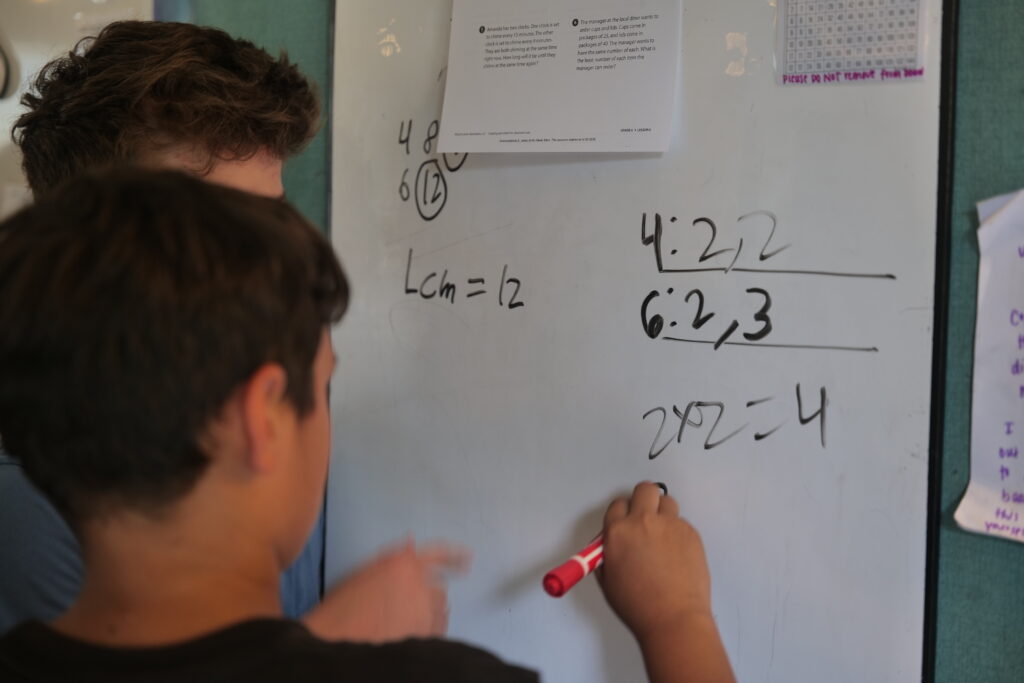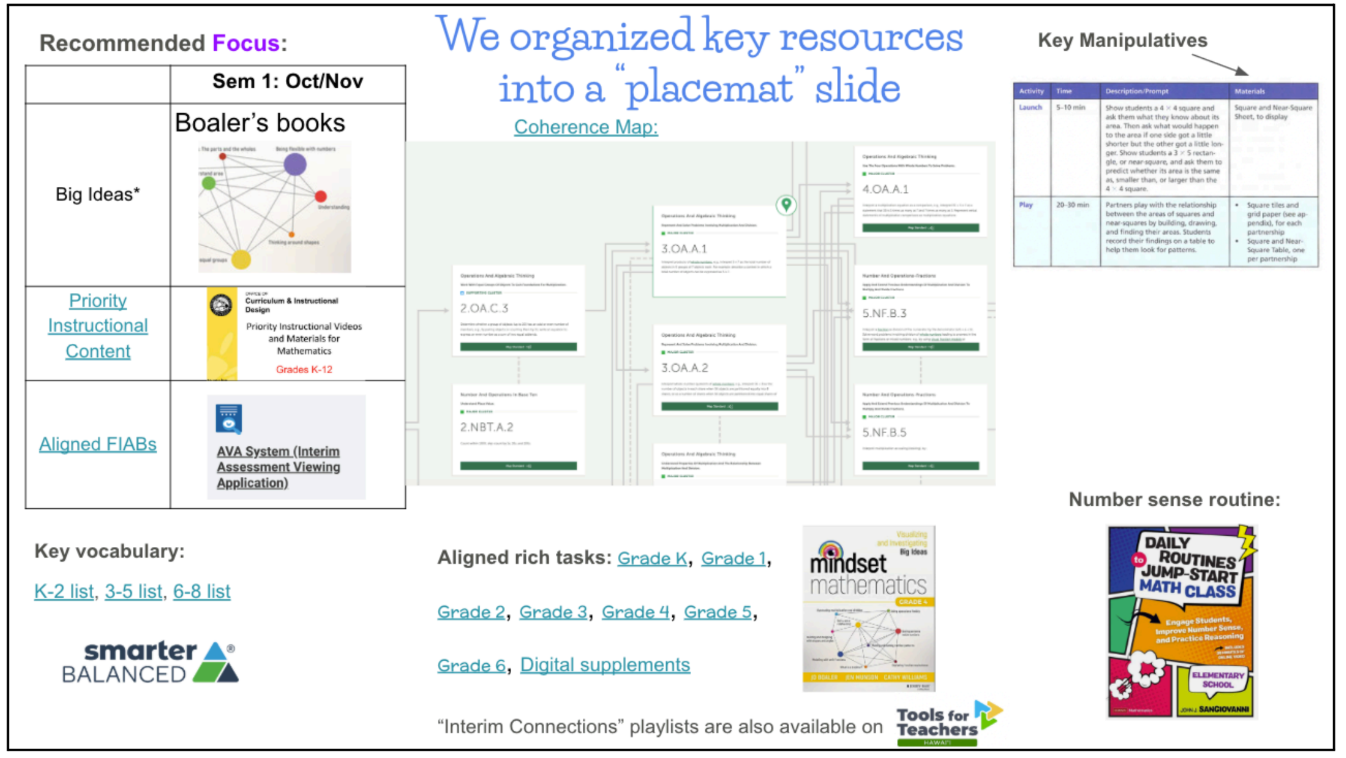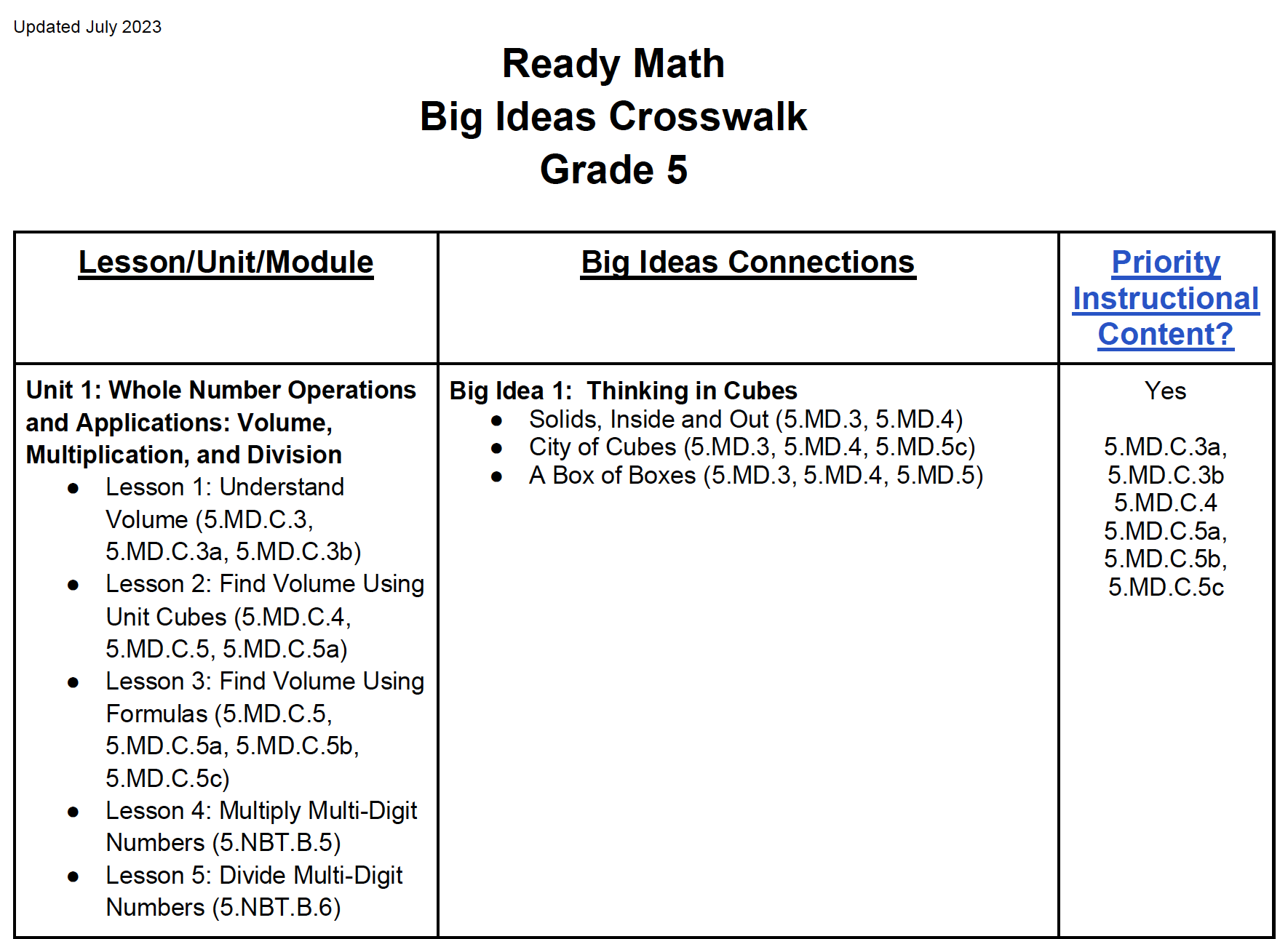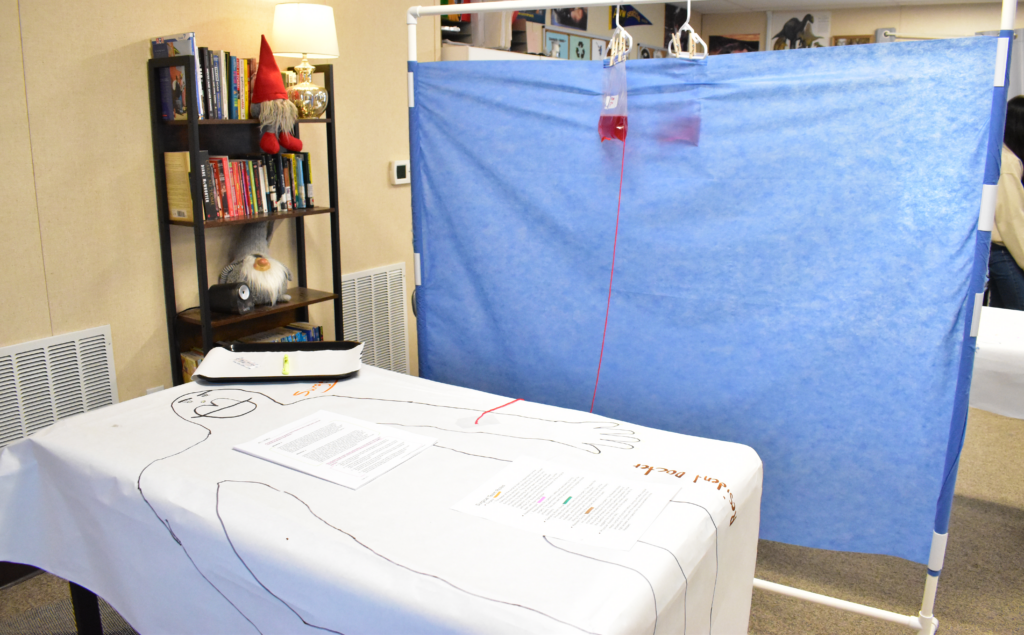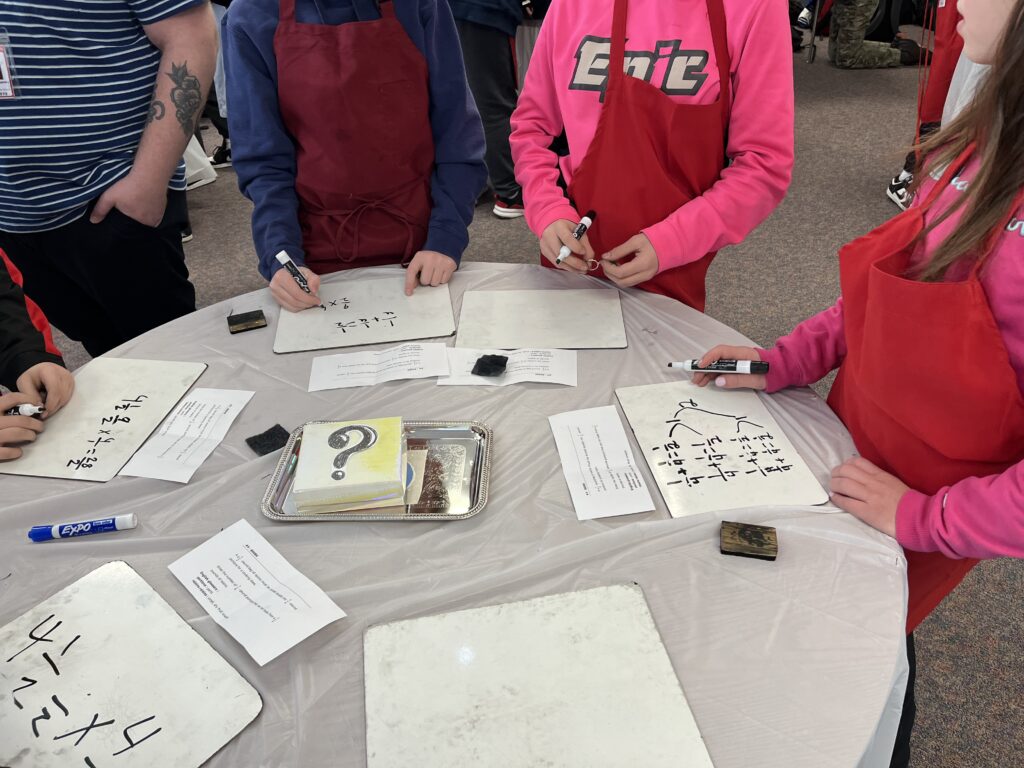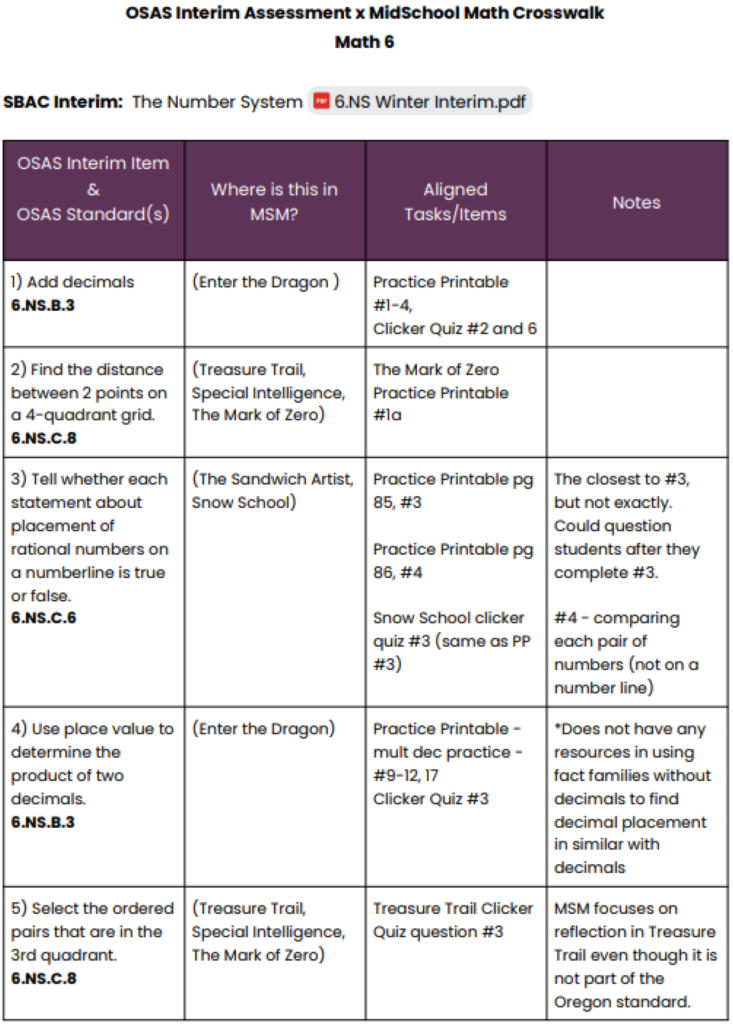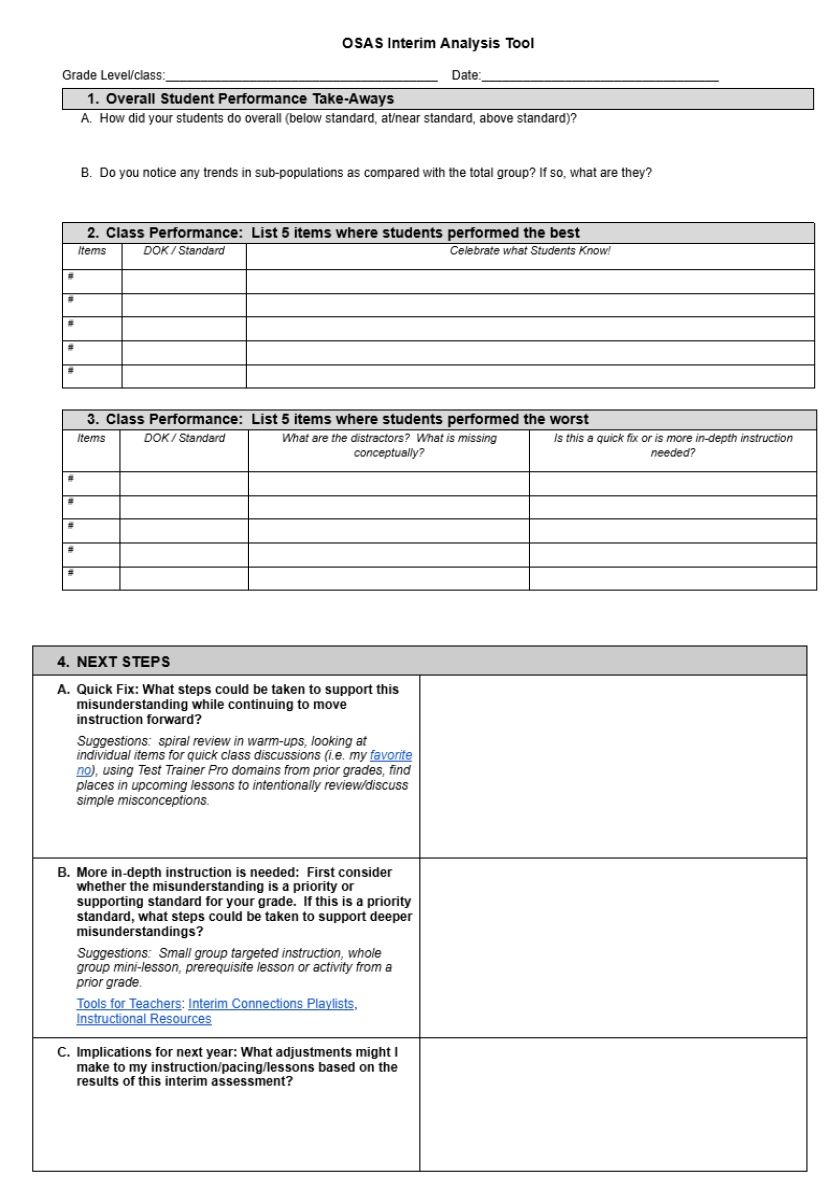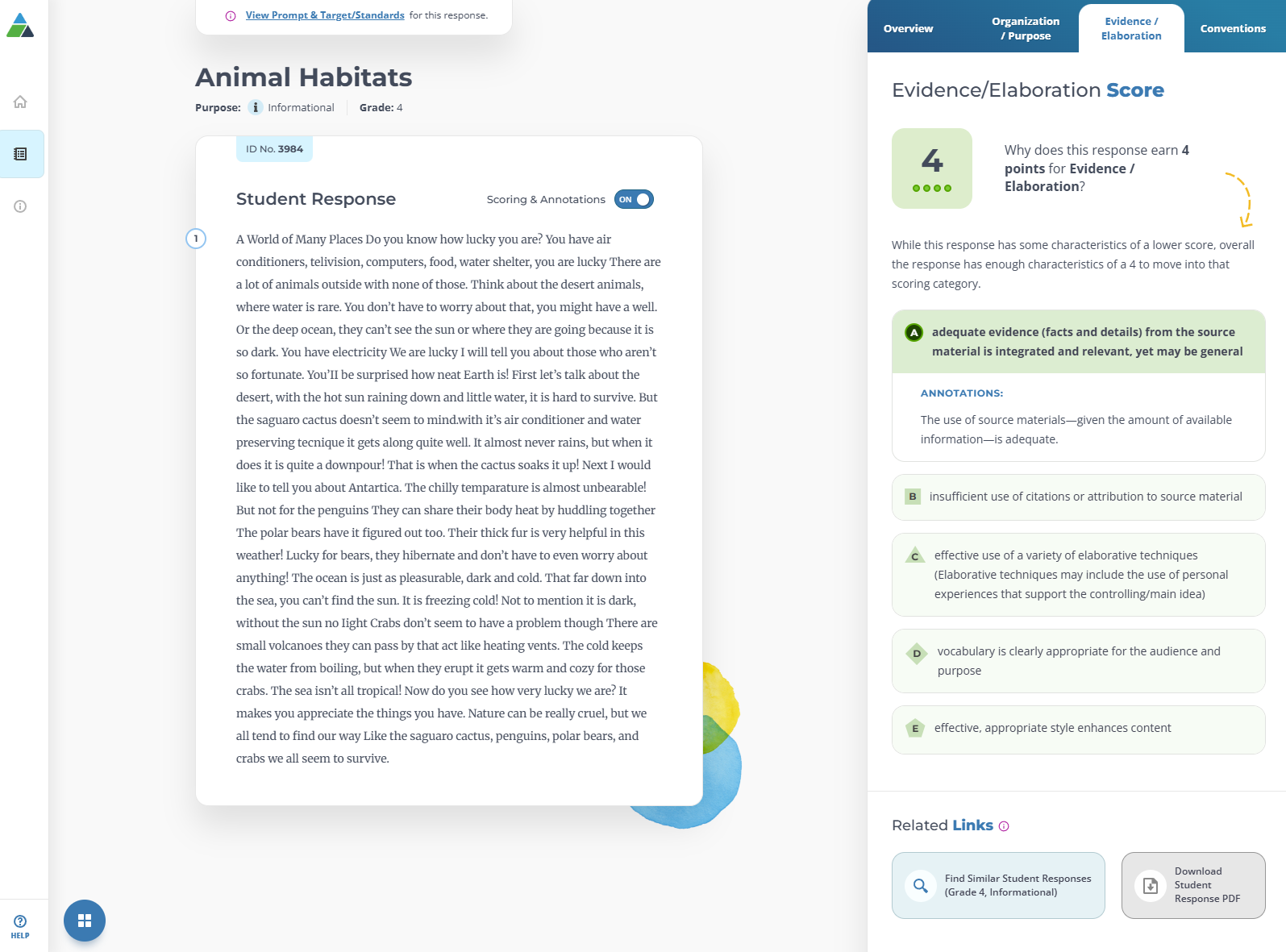Teaching and Learning Innovation Awards
Celebrating Educator-Led Innovation
Congratulations to the Smarter Balanced Teaching and Learning Innovation Awards recipients! We are grateful for the interest and enthusiasm around this award cycle and the opportunity to learn about innovative practices that align with our commitment to educational excellence. Congratulations and thank you for your commitment to improving teaching and learning for our nation’s students!
Highlights
Hawaii’s Kailua-Kalāheo Complex Area transformed math learning with Smarter Balanced tools in the following ways:
- Curated digital placemats — interactive, grade-level math resources that combined aligned Focused Interim Assessment Blocks (FIABs), key vocabulary, manipulatives, rich tasks, and vertical coherence maps
- Teacher-led professional development and assessment integration ideas including empathy (sitting in the seat of the students)
- Student voice — Designed and administered the “Kalāheo Math Mindsets Student Survey” to gather perception data from students about their math experiences (n=389)
Local Context and Engagements
Problem
Located in the Kailua community on the east side of O‘ahu, the Kailua-Kalāheo Complex Area faced a math dilemma — persistent underperformance in math spanning multiple years. When looking at the cohort of students who stayed from 6th grade to 11th grade, the data revealed a troubling trend: 59% of students declined in math proficiency as they progressed in the system, and only 4% improved.
District Solution
To tackle this problem head on, the Kalāheo Math Task Force — composed of teacher leaders, administrators, and district specialists across six schools — used a Math Mindsets Student Survey to gather perceptual data from students. They sampled 389 students from sixth, eighth, and 12th grade to better understand student perceptions around math. What the teachers learned surprised them — the lack of performance and progress wasn’t due to low motivation. This survey data allowed the Math Task Force to create Digital Placemats — interactive resources that connect big ideas, high-priority math content, and aligned FIABs with student-friendly lessons and rich tasks.
“The work of the Math Task Force stands out as a model of data-driven, student-centered innovation, and it is exciting to see these efforts acknowledged at the consortium level.” — Brian Reiter Administrator, Assessment Section, Hawaii State Department of Education
What is a Curated Digital Placemat?
The purpose of the Curated Digital Placemats are to:
- Deepen teachers’ conceptual knowledge
- Support teachers as they use Smarter Balanced FIAB data as part of professional learning community discussions
- Support implementation of teaching practices including: key vocabulary, manipulatives related to that topic, and aligned number sense routines
The template featured the “Priority Instructional Content” (PIC) along with a “Coherence Map” that described the vertical alignment of the content standards in each grade level to build towards the “Big Ideas” from Dr. Boaler’s Mindset Mathematics: Visualizing and Investigating Big Ideas books.
Image of sample Grade 5 crosswalk alignment of Big Ideas and rich tasks to Ready Math curricular resource.
What was the Kalāheo Math Mindsets Student Survey?
In August 2019, to gather perception data from students, Kailua-Kalāheo Complex Area sampled 389 students from sixth grade to eighth grade, and 12th grade with a survey tool named the “Kalaheo Math Mindsets Student Survey.”
What is a Rich Task?
The Math Task Force brought teachers together to experience the Smarter Balanced FIABs like a student to:
- Better understand what skills students need to demonstrate
- Meaningfully engage in Rich Tasks when they are used as lessons with students to deepen their understanding
The image below shows an example of a Rich Task: “How Fast Do You Walk."
Innovative Practices and Strategies
- Focused on specific target-level data from the Summative Assessment to identify high-leverage focus areas by grade and semester
- Provided critical information that was easily accessible to all teachers by curating digital placemats — interactive, grade-level resources that combined aligned FIABs, key vocabulary, manipulatives, rich tasks, and vertical coherence maps
- Administered common FIABs and engaged students in aligned instructional routines
- Embedded professional learning with an emphasis on developing teacher empathy and insight by engaging in students’ experiences of assessments and rich tasks in advance of administering the resources to students
Implementation Approach
Between 2019 and 2025, the Task Force sustained its impact through a replicable and scalable structure:
- They administered the Kalāheo Math Mindsets Student Survey to 389 students across grades 6, 8, and 12 to challenge assumptions about student motivation and identify perceptual barriers to success.
- Using Smarter Balanced target-level reports, the Math Task Force identified high-leverage focus areas per grade and semester. These targets were selected based on alignment with priority instructional content, performance trends, and growth potential.
- The district convened a representative group of teacher leaders, administrators, and support staff from six schools across the PK-12 pipeline to identify common needs and co-create solutions. More than 27 stakeholders — including teachers, principals, coaches, and district staff — led this grassroots initiative.
- The Math Task Force mapped identified focus areas to specific FIABs and agreed on common timelines and administration formats to promote consistency across schools.
- Grade-level teams created interactive “digital placemats” for each focus area, aligning instructional materials, vocabulary, manipulatives, rich tasks, and SBA tools — all tailored to support the selected FIABs.
- Trainings were informed by research (e.g., Dr. Boaler’s “Big Ideas”) and customized to meet the unique needs of each grade level. Teacher representatives led workshops, including modeling rich tasks, reflecting on instructional moves, planning interventions, meeting quarterly, rotating host schools for observations, and conducting continuous feedback loops.
Results and Findings
Teachers report improved clarity, instructional alignment, and professional confidence. Student engagement in assessments increased, and collaborative analysis of FIAB data has become routine practice. The model’s integration of Smarter Balanced tools with high-impact instructional practices makes it a beacon for Consortium-wide innovation.
This initiative has had a lasting impact as it has served 3,772 students and 153 math teachers and has been adopted in another Hawaii Complex serving a K-12 pipeline. While secondary scores remain below pre-pandemic levels, some elementary schools achieved their highest math proficiency rates in history in recent years.
References
- Boaler, J., Munson, J., & Williams, C. (2021). Mindset mathematics: Visualizing and investigating big ideas, Grade 1. John Wiley & Sons.
- Boaler, J. and Foster, D. (2021). Raising Expectations and Achievement: The Impact of Two Wide Scale De-Tracking Mathematics Reforms
Learn More
The Understanding the Smarter Balanced Interim Assessments video explores the Smarter Balanced Interim Assessments and how they can support teaching and learning throughout the year.
Why Interim Assessments are important for students and educators:
- They provide information about what students know and can do, so that both teachers and students can make adjustments to improve teaching and learning.
- They assess college and career readiness skills like:
- organization
- critical thinking
- problem solving
- They utilize a full range of item types similar to Smarter Balanced Summative Assessments.
FIABs target a smaller range of concepts and skills compared to the IABs — for example, analyzing research and geometry are focused IABs. They provide educators with a more detailed understanding of what students know and can do for a very fine grained set of content like the IABs. There are many available focused IABs for each grade and content area. Like the Summative Assessments, Interims are computer based and fully accessible. They offer a range of accessibility features (e.g., universal tools, designated supports and accommodations) for students.
Interim Blocks, including the IABs and FIABs, are unique to the Smarter Balanced Assessment System, because each one is associated with a Connections Playlist. Educators can use Connections Playlists in multiple ways. For example, educators can use them to:
- Support students by using performance progressions to understand and interpret students' Interim Assessment results
- Plan instruction by using descriptions of student performance to inform and plan instructional next steps
- Take action by using educator-created classroom ideas and resources to support student success
The Interim Assessments, along with the Summative Assessments and Tools for Teachers, are designed to work together to support high-quality teaching, improve learning for all students, and prepare students for life after high school.
Highlights

Idaho’s Timberlake Middle School from the Lakeland Joint School District transformed Smarter Balanced resources into dynamic, career-connected learning experiences in the following ways:
- The school embraced both community and teacher engagement to identify students’ needs and instructional priorities.
- The school allocated teacher planning time during which they used formative and Interim Assessment data to personalize instructional next steps to meet the needs of individual students.
- To make lessons more engaging and relevant for students, teachers created themed stations — complete with props, costumes, and collaborative roles — that provided students with real-world application opportunities rather than abstract problems.
Grade 7 Math: Budget Planner Ratios and Proportional Relationships
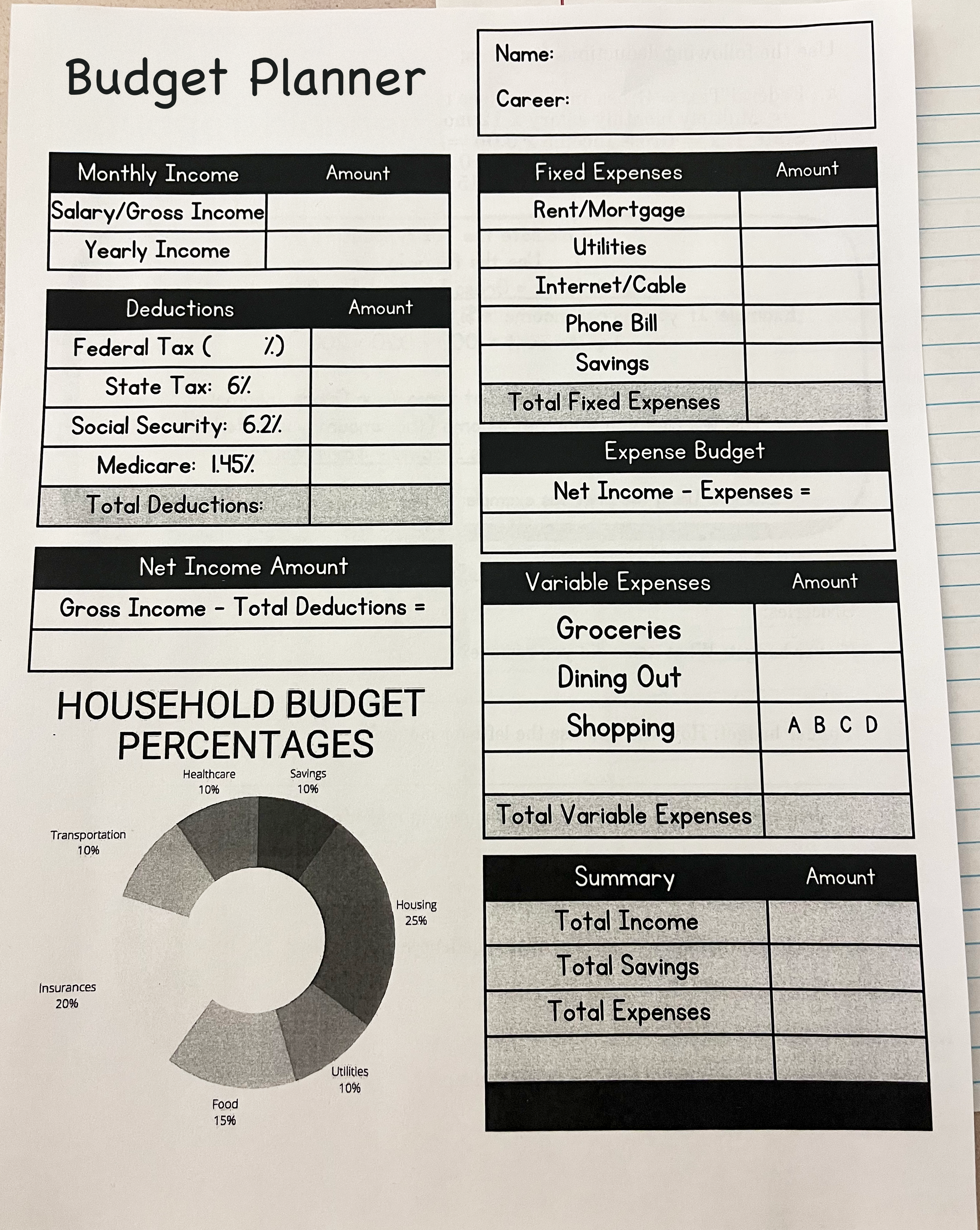
Grade 7 ELA: “Surgical Teams” Research, Analyze, and Integrate Information
Grade 6 Math: “Math-ter Chef” Mastering Division of Fractions
Local Context and Engagements
Problem
Based on surveys of educators and students, Timberlake Middle School determined that students needed hands-on learning experiences that focused on the trades and career opportunities beyond high school so that instruction was engaging and relevant.
District Solution
Timberlake Middle School used Smarter Balanced’s Interim Assessment Blocks (IABs) and Focused IABs (FIABs) — alongside Tools for Teachers — to inspire high-engagement, locally themed lessons that are designed to encourage student agency and lead to content mastery. The school formed small “innovation teams” (one teacher, one administrator, plus the testing coordinator) that met bimonthly in focused 20-minute sessions.
Innovative Practices and Strategies
Timberlake Middle School transformed Smarter Balanced Interim Assessment data into designing dynamic, career-connected learning experiences as follows:
- Teachers co-constructed lessons with the testing coordinator, then used Tools for Teachers to inspire real-world experiences. This use of Smarter Balanced resources keeps instruction aligned with Idaho’s Content Standards, and therefore serves as a model for teachers on how to utilize assessment data to prioritize student learning needs and generate dynamic learning tasks that help address instructional gaps.
- Students rotated through themed stations — complete with props, costumes, and collaborative roles — that made abstract problems tangible.
Implementation Approach
This implementation strategy was across the academic year, with Interim Assessments being administered from October through January.
- Small teams composed of one teacher, one administrator, and the testing coordinator met bimonthly.
- These focused, 20-minute sessions analyzed top-missed questions and developed customized strategies.
- Each team identified the five most-missed questions and corresponding standards to drive instructional decisions. This step ensured teaching was laser-focused on ensuring that instruction is aligned to the Idaho Content Standards.
- Using the FIAB Connections Playlists and the associated Tools for Teachers resources as inspiration, educator teams co-created immersive, real-word lesson experiences (e.g., “Math-ter Chef," surgical ELA simulations, and “Game of Life” math). These made practice tangible, fun, and rooted in career-connected applications.
- Teams began their creative redesign by holding one initial planning meeting and at least two brief follow-ups before classroom rollout.
- Following instruction, teachers gave the same FIAB assessments again to assess growth and instructional effectiveness, closing the loop between assessment and action.
- Educators surveyed students informally to refine themes and ensure that lessons met local interests. All materials — props, lesson outlines, digital playlists — are centrally housed for cross-curricular reuse, ensuring scalability without adding to teachers’ workloads.
“This award celebrates the power of collaboration, creativity, and technology in the classroom. Using assessment data as a foundation, our teachers embraced new, differentiated approaches and co-created innovative lessons that engaged students. With technology as a bridge, we turned data into action — building personalized, hands-on learning experiences that made a real impact.” — Melanie Wirth, Library Lead and Testing Coordinator, Timberlake Middle School
Results and Findings
Based on the readministration of FIABs, students demonstrated significant improvement in the targeted standards. Feedback from educators and students identified unprecedented levels of motivation and collaboration. Teachers reported that real-time data analysis followed by immediate, context-rich intervention made the Smarter Balanced Assessment System feel both usable and powerful in daily instruction.
Learn More
Tools for Teachers hosts teacher-created, standards-aligned instructional resources (lesson plans) that incorporate the formative assessment process with embedded formative assessment, accessibility strategies, and printable worksheets.
Highlights
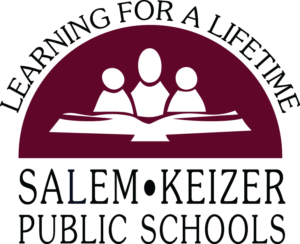
Oregon’s Salem-Keizer Public Schools’ innovative practice connects the pieces in the following ways:
- Leveraged the Smarter Balanced Interim Assessments as core instructional resources as part of implementing a new district curriculum
- Engaged teachers in curriculum unit mapping to develop math crosswalks that linked Smarter Balanced Math Interim Assessments with the new curriculum
- Leveraged the expertise of the New Teacher Center to bring intentional, job-embedded professional development to teacher leaders who then supported their schools’ professional learning communities (PLCs)
Local Context and Engagements
Problem
Proficiency rates in the Salem-Keizer Public Schools, which is Oregon’s second-largest school district, had fallen to historic lows in grades 6-8, and teachers lacked confidence in existing assessment solutions.
District Solution
The district chose to do something innovative: integrate Smarter Balanced Interim Assessments aligned with the first-year implementation of a brand-new math curriculum. Leadership mobilized quickly, working with teachers to select high-quality materials and, in parallel, utilizing Smarter Balanced Interim Assessments to triangulate high-quality instructional curricular materials, assessment, and instruction in their middle school math classrooms.
Innovative Practices and Strategies
The innovative strategy was simple but powerful:
- The district addressed curriculum, instruction and assessment simultaneously by implementing the new curriculum as well as initiating standardized use of Smarter Balanced Interim Assessments.
- The district selected two Interim Assessments per grade level and linked them to curriculum units across 12 middle schools.
- The district leveraged NTC to train PLCs on how to best use Smarter Balanced assessment data to guide instruction.
Below: Sample crosswalk between Interim Assessment items, OSAS standards, and curriculum.
Implementation Approach
Planning began in Spring 2024 when Math Program Associates previewed Smarter Balanced Interim Assessment Blocks (IABs) and Focused IABs, identifying math crosswalks with the newly selected curriculum materials.
- A cohort of 15 teacher leaders — one from each middle school — engaged in sustained professional development with the NTC.
- They learned to preview interims, analyze data, and align assessment tasks with daily instruction.
- This empowered them to lead PLCs and support building-wide implementation.
- Training took place in the summer and fall of 2024, including three-day curriculum rollouts, security protocols, and standardized administration procedures.
- Interim Assessments were delivered in November and February — right after instruction — providing timely insights for teachers and PLCs.
- The teacher-leader cohort played a pivotal role in leading data analysis sessions and modeling instructional adjustments using an “Oregon Statewide Assessment System Interim Analysis Tool."
- Many PLCs adopted Smarter Balanced Interims in place of curricular unit tests, citing stronger alignment and better feedback.
“This work transformed how our teams move through the cycle of teaching and learning, embedding aligned assessments as a tool to deepen instruction and extend student mastery. The power of educator collaboration around the Smarter Balanced Interim Assessments was evidenced in their increased comfort with the new curriculum, clarity about level and pace of student mastery, and use of actionable data to support every learner.” — Danielle Neves, Deputy Superintendent of Salem-Keizer Public Schools
Below: Interim Analysis Tool used in PLCs while reviewing results
Results and Findings
Early results are encouraging.
- This work, alongside the implementation of Smarter Balanced Interim Assessments, built teacher trust and confidence with the curriculum.
- Teachers embraced Interim Assessment reporting tools and learned how to interpret item-level data, assess student needs, and improve learning outcomes in real-time.
- This resulted in positive perceptions from teachers that the curricular tasks aligned well with the interim items’ format and rigor, and content could be used as a tool to prepare students for future endeavors with high-quality instructional materials.
Compared to the previous assessment data, more students demonstrated readiness in key math domains after just one Interim, and teachers have been able to leverage item analysis data to dig deeper into student needs.
Teachers now report higher trust in their curriculum, greater instructional focus, and deeper conversations about student learning. “This work absolutely needs to continue,” one teacher leader said. “It has given me a new lens to view planning, instruction, and assessment together.” The impact of Salem-Keizer’s work extends well beyond numbers. By embedding assessments into instruction and teacher learning, they’ve created a system that’s more responsive, coherent, and student-centered.
Learn More
The Understanding the Smarter Balanced Interim Assessments video explores the Smarter Balanced Interim Assessments and how they can support teaching and learning throughout the year.
Why Interim Assessments are important for students and educators:
- They provide information about what students know and can do, so that both teachers and students can make adjustments to improve teaching and learning.
- They assess college and career readiness skills like:
- organization
- critical thinking
- problem solving
- They utilize a full range of item types similar to Smarter Balanced Summative Assessments.
The IABs address a fairly broad yet related set of concepts and skills like measurement and data or reading informational texts. IABs help teachers and students check where they are in their learning and use the results to make adjustments. There are multiple IABs for each grade and content area. Like the Summative Assessments, Interims are computer based and fully accessible. They offer a range of accessibility features (e.g., universal tools, designated supports and accommodations) for students.
Interim Blocks, including the IABs and FIABs are unique to the Smarter Balanced Assessment System, because each one is associated with a Connections Playlist. Educators can use Connections Playlists in multiple ways. For example, educators can use them to:
- Support students by using performance progressions to understand and interpret students' Interim Assessment results.
- Plan instruction by using descriptions of student performance to inform and plan instructional next steps
- Take action by using educator-created classroom ideas and resources to support student success
The Interim Assessments, along with the Summative Assessments and Tools for Teachers are designed to work together to support high-quality teaching, improve learning for all students, and prepare students for life after high school.
Highlights
 South Dakota’s Harrisburg School District used the power of Smarter Balanced resources and tools to support better student writing in the following ways:
South Dakota’s Harrisburg School District used the power of Smarter Balanced resources and tools to support better student writing in the following ways:
- Leveraging Tools for Teachers Instructional Resources (lessons) like “Digits Down,” “Unboxing,” and “Crack the Code” to target learning gaps and give alternative teaching strategies
- Using the Smarter Balanced Annotated Response Tool (SmART) to annotate writing samples to model proficient work and build stronger writers in students
- Building teacher capacity by leveraging instructional toolkits with Smarter Balanced resources so teachers could have more confidence to implement high-quality, evidence-based instruction practices
Local Context and Engagements

Harrisburg High School
Problem
The Harrisburg School District consists of approximately 6,200 students and 1,000 staff members across seven elementary schools, three middle schools, and one high school. Despite dedicated efforts to ensure all students have access to high-quality instruction, staff analysis of summative and interim assessment data indicated that there were groups of students who were performing well below the proficient achievement standard.
District Solution
The district harnessed the full Smarter Balanced suite — Interim Assessments, Tools for Teachers, and the Smarter Annotated Response Tool — to address the needs of all of their students in grades 3-5 and boost teaching and learning outcomes. District leaders and teachers, guided by instructional coaches, identified the lack of high-quality, standards-aligned resources as a critical barrier to student learning. The initiative served 1,200 students and 60 teachers across three elementary schools.
Innovative Practices and Strategies

Harrisburg East Middle School
By embedding the following resources into district-developed instructional units, educators were able to free up planning time to focus on differentiated instruction and student relationships:
- Used assessment data to prioritize lesson plans from Tools for Teachers that address the greatest needs and serve to promote standards-aligned and high-quality instructional practices.
- Used the Smarter Annotated Response Tool (SmART) to enhance accessibility by providing concrete examples of student writing. This enabled teachers to scaffold instruction effectively, empowering all learners to meet and exceed grade-level expectations.
- Leveraged the expertise of the New Teacher Center to bring intentional, job-embedded professional development regarding how to effectively use Interim Assessments to establish clear baselines and measure student progress across the academic year.
What’s the Smarter Annotated Response Tool?
The Smarter Annotated Response Tool provides annotated examples which can be used instructionally to model effective writing and critical reading strategies. For example, in an ELA module focusing on argumentative writing, the teacher can use annotated examples to guide students through text analysis, identifying strong evidence, and crafting cohesive arguments. The image below shows a Smarter Annotated Response Tool illustration from a Grade 4 Informational Text: Animal Habitats with a full credit student response and annotation enabled for the evidence/elaboration score.
Implementation Approach
This initiative leveraged Smarter Balanced Interim Assessments to narrow achievement gaps and engage students in instruction aligned with ELA and math state standards as well as Smarter Balanced instructional resources and assessments.
- A pilot in fall 2024 engaged 10 teachers, five administrators, and 176 students.
- Professional development was a cornerstone of this initiative, equipping teachers with the skills and knowledge necessary to effectively implement Smarter Balanced resources.
- Teachers participated in a two-day professional development workshop
- Teachers met in professional learning communities every other month to analyze interim data, share best practices, and refine lessons.
- Instructional coaches provided ongoing one-on-one support, while district leaders monitored progress through monthly checkpoints and classroom observations.
“The Smarter Balanced Annotated Response Tool helped our teachers model strong writing and give clear, scaffolded feedback. It’s strengthened student writing and built teacher confidence in delivering high-quality instruction.” – Michael Amolins, Director of Academic Services, Harrisburg School District
Results and Findings
Teachers reported increased confidence using data to tailor instruction, and student engagement surveys reflected a clearer understanding of learning targets.
Harrisburg’s model demonstrates a scalable, repeatable pathway from district adoption of Smarter Balanced resources to scheduling periodic professional learning activities to leveraging instructional coaches in order to narrow achievement gaps, boost assessment literacy, and enhance instructional quality. This comprehensive approach supports continuous improvement in instructional quality and measurable gains in student achievement.
Learn More
SmART Annotation Tool - grow writing in your classroom and learn how writing is scored on Smarter Balanced assessments using these annotated student samples.
Highlights
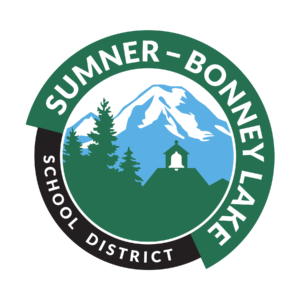 Washington’s Sumner-Bonney Lake School District Implemented a deep dive into teacher’s lessons (“Lesson Study”) that included:
Washington’s Sumner-Bonney Lake School District Implemented a deep dive into teacher’s lessons (“Lesson Study”) that included:
- Teacher-driven professional learning, including: co-planning lessons, providing peer feedback on instruction, and co-evaluating formative assessment data to address student learning gaps beyond basic routine data analysis
- Engaged in a focus on the math content as well as the language demands that is embedded in their newly adopted math curriculum
- Ensured that all students were able to access the depth and breadth of the rigorous curriculum by embracing Universal Design for Learning (UDL) to create meaningful learning experiences for all students and expanding supports for multilingual students
Local Context and Engagements
Problem
The Sumner-Bonney Lake School District in Washington serves more than 11,000 students, including nearly 2,350 in grades 3-5. Within this population, multilingual learners and low-income students face persistent achievement gaps in math, scoring significantly lower than their peers on Smarter Balanced Assessments. Additionally, the district recently adopted a new math curriculum that served as an opportunity for the district to provide teachers professional learning to support implementation.
District Solution
The district’s goal was ambitious, to ensure 80% of fifth graders meet or exceed grade-level math standards by 2026. The district targeted professional learning grounded in collaborative inquiry and focused on math instruction in grades 3-5. Equipped with Professional Learning Communities (PLCs), the district used a structured, data-driven approach to identifying and addressing student needs. Using Smarter Balanced Assessment data, PLCs analyzed achievement trends, pinpointing specific areas where students are struggling, and set measurable goals to narrow achievement gaps. This targeted approach ensured that the instructional adjustments were directly informed by student performance data, making the intervention needs-based and evidence-driven.
Innovative Practices and Strategies
The district’s innovation centered around the "Lesson Study," which put data into action by supporting teachers and empowering students through more responsive, equitable instruction:
- Teachers engaged in a collaborative inquiry cycle, working within their PLCs to examine how their instructional strategies impact student learning.
- A team of teachers were released for a full day to collaboratively plan, analyze, and refine a lesson.
- This ongoing, iterative process enables teachers to assess the effectiveness of their interventions, adjust practices as needed, and continuously work toward equitable learning opportunities.
- Teachers used Smarter Balanced Summative and Interim Assessment data to identify areas of need, co-plan a math lesson, deliver it inside a “lab classroom,” and then analyze its effectiveness using student work and observations.
- Teachers integrated UDL strategies, including language scaffolds for multilingual learners and rigorous instructional planning, to close learning gaps.
Implementation Approach
Since launching this innovation in the 2023-24 school year, the initiative has supported 22 teachers, six administrators, and 527 students across three pilot schools.
- PLCs collaborate with math Teachers on Special Assignment, curriculum reps, and administrators.
- Each team goes through at least two rounds of Lesson Study, beginning with data analysis for the Smarter Balanced Summative Assessment followed by Interim Assessment data.
- Unlike traditional lesson study, this approach emphasizes inquiry: How do instructional decisions impact student learning?
- The lessons are co-designed to address identified needs and instructional focus.
- Once the focus is determined, teachers examine the curriculum to identify how the targeted skill is addressed and use data-driven approaches to observe student learning and reflect on progress.
- A key strength of this approach is its embedded UDL strategies for multilingual students and academic rigor to challenge students with appropriate multiple modalities of instruction, ensuring that all students have the opportunity to engage with high-quality, rigorous content.
- The collaborative teaching “lab” allows for deeper study and professional growth that benefits both students and the collective of teachers.
- The initiative is scalable, with a mentorship model training teacher leaders and math representatives to extend the approach district-wide.
Results and Findings
The data is compelling over the past three years. In classrooms where teachers engaged in Lesson Study, third graders whose test results were categorized as "below standard" dropped by 50%, while the results for fourth graders classified as "above standard" jumped from 27% to 70%. Fifth grader results improved by 25 percentage points compared to a district average gain of 14. These gains are not just academic.
Teachers report increased student engagement, confidence, and participation, particularly among multilingual learners. Just as important, educators feel more empowered and prepared to support all students through reflective, data-informed practice. Lesson Study is proving to be not just a professional development model, but a movement toward instructional equity.
Learn More
Universal Design for Learning is a core principle of the Smarter Balanced Assessment System and accessibility for students. Smarter Balanced tests are designed so that students who take them — including students who are learning English or have special needs — can participate in the tests meaningfully and demonstrate what they know and can do. As a result, our interim and end-of-year test includes accessibility resources that address visual, auditory, and physical access barriers — allowing virtually all students who take the test to show what they know and can do without compromising the assessment construct.
Usability, Accessibility, and Accommodations Guidelines can be used to help teachers identify appropriate student supports and to ensure that students can meaningfully participate in Smarter Balanced Assessments.


